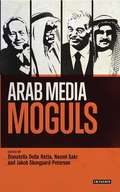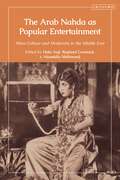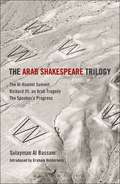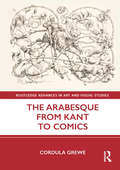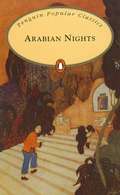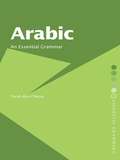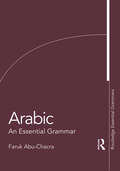- Table View
- List View
Arab Media Moguls: Community, Legitimacy And Public Life
by Naomi Sakr Jakob Skovgaard-Petersen Donatella Della RattaTransformations in the Arab media landscape are a key element in regional dynamics of political change. Where do private owners of Arab media outlets stand on the scene? What part, if any, have they played in weakening dictatorships, countering sectarianism and political polarisation, and reforming business practices in the Arab world? Arab Media Moguls charts the fortunes of some leading media investors and entrepreneurs from Egypt, Lebanon, Saudi Arabia and Tunisia to examine their motives, management styles, financial performance and links to political power. The resulting profiles offer intriguing insights into the place of family, education, religion and media regulation in regional power structures.Globally, the rise of small digital media, increased competition law and the precedence of more digitally-savvy younger generations have fuelled doubts as to whether the archetypal 'media mogul' is a phenomenon with a future. How do such factors affect power plays in Arab media? Responding critically to existing Western scholarship and commentary on magnates in US and European media, this book explores how far existing assumptions and perceptions about powerful media owners' eccentricity, innovation and risk-taking apply in the Arab context and offers a range of alternative approaches to understanding the central position of certain individuals in the fast-changing Arab media business.
Arab Media Systems (Global Communications #3)
by Carola Richter and Claudia KozmanThis volume provides a comparative analysis of media systems in the Arab world, based on criteria informed by the historical, political, social, and economic factors influencing a country’s media. Reaching beyond classical western media system typologies, 'Arab Media Systems' brings together contributions from experts in the field of media in the Middle East and North Africa (MENA) to provide valuable insights into the heterogeneity of this region’s media systems. It focuses on trends in government stances towards media, media ownership models, technological innovation, and the role of transnational mobility in shaping media structure and practices. Each chapter in the volume traces a specific country’s media – from Lebanon to Morocco – and assesses its media system in terms of historical roots, political and legal frameworks, media economy and ownership patterns, technology and infrastructure, and social factors (including diversity and equality in gender, age, ethnicities, religions, and languages). This book is a welcome contribution to the field of media studies, constituting the only edited collection in recent years to provide a comprehensive and systematic overview of Arab media systems. As such, it will be of great use to students and scholars in media, journalism and communication studies, as well as political scientists, sociologists, and anthropologists with an interest in the MENA region. This volume provides a comparative analysis of media systems in the Arab world, based on criteria informed by the historical, political, social, and economic factors influencing a country’s media. Reaching beyond classical western media system typologies, Arab Media Systems brings together contributions from experts in the field of media in the Middle East and North Africa (MENA) to provide valuable insights into the heterogeneity of this region’s media systems. It focuses on trends in government stances towards media, media ownership models, technological innovation, and the role of transnational mobility in shaping media structure and practices. Each chapter in the volume traces a specific country’s media – from Lebanon to Morocco – and assesses its media system in terms of historical roots, political and legal frameworks, media economy and ownership patterns, technology and infrastructure, and social factors (including diversity and equality in gender, age, ethnicities, religions, and languages). This book is a welcome contribution to the field of media studies, constituting the only edited collection in recent years to provide a comprehensive and systematic overview of Arab media systems. As such, it will be of great use to students and scholars in media, journalism and communication studies, as well as political scientists, sociologists, and anthropologists with an interest in the MENA region. This volume provides a comparative analysis of media systems in the Arab world, based on criteria informed by the historical, political, social, and economic factors influencing a country’s media. Reaching beyond classical western media system typologies, Arab Media Systems brings together contributions from experts in the field of media in the Middle East and North Africa (MENA) to provide valuable insights into the heterogeneity of this region’s media systems. It focuses on trends in government stances towards media, media ownership models, technological innovation, and the role of transnational mobility in shaping media structure and practices. Each chapter in the volume traces a specific country’s media – from Lebanon to Morocco – and assesses its media system in terms of historical roots, political and legal frameworks, media economy and ownership patterns, technology and infrastructure, and social factors (including diversity and equality in gender, age, ethnicities, religions, and languages). This book is a welcome contribution to the field of media studies, constituting the only edited collection in recent years to provide a comprehensive and systematic overview of Arab media systems. As such, it
The Arab Nahda as Popular Entertainment: Mass Culture and Modernity in the Middle East
by Hala Auji Raphael Cormack Alaaeldin MahmoudWhat was popular entertainment like for everyday Arab societies in Middle Eastern cities during the long nineteenth century? In what ways did café culture, theatre, illustrated periodicals, cinema, cabarets, and festivals serve as key forms of popular entertainment for Arabic-speaking audiences, many of whom were uneducated and striving to contend with modernity's anxiety-inducing realities? Studies on the 19th to mid-20th century's transformative cultural movement known as the Arab nahda (renaissance), have largely focussed on concerns with nationalism, secularism, and language, often told from the perspective of privileged groups. Highlighting overlooked aspects of this movement, this book shifts the focus away from elite circles to quotidian audiences. Its ten contributions range in scope, from music and visual media to theatre and popular fiction. Paying special attention to networks of movement and exchange across Arab societies in Lebanon, Syria, Egypt, Iraq, and Morocco, this book heeds the call for 'translocal/transnational' cultural histories, while contributing to timely global studies on gender, sexuality, and morality. Focusing on the often-marginalized frequenters of cafés, artist studios, cinemas, nightclubs, and the streets, it expands the remit of who participated in the nahda and how they did.
The Arab Nahda as Popular Entertainment: Mass Culture and Modernity in the Middle East
by Hala Auji Raphael Cormack Alaaeldin MahmoudWhat was popular entertainment like for everyday Arab societies in Middle Eastern cities during the long nineteenth century? In what ways did café culture, theatre, illustrated periodicals, cinema, cabarets, and festivals serve as key forms of popular entertainment for Arabic-speaking audiences, many of whom were uneducated and striving to contend with modernity's anxiety-inducing realities? Studies on the 19th to mid-20th century's transformative cultural movement known as the Arab nahda (renaissance), have largely focussed on concerns with nationalism, secularism, and language, often told from the perspective of privileged groups. Highlighting overlooked aspects of this movement, this book shifts the focus away from elite circles to quotidian audiences. Its ten contributions range in scope, from music and visual media to theatre and popular fiction. Paying special attention to networks of movement and exchange across Arab societies in Lebanon, Syria, Egypt, Iraq, and Morocco, this book heeds the call for 'translocal/transnational' cultural histories, while contributing to timely global studies on gender, sexuality, and morality. Focusing on the often-marginalized frequenters of cafés, artist studios, cinemas, nightclubs, and the streets, it expands the remit of who participated in the nahda and how they did.
The Arab Nahdah: The Making of the Intellectual and Humanist Movement (Edinburgh Studies in Modern Arabic Literature)
by Abdulrazzak PatelTo understand today's Arab thinking, you need to go back to the beginnings of modernity: the nahdah or Arab renaissance of the 19th and early 20th centuries. Abdulrazzak Patel enhances our understanding of the nahdah and its intellectuals, looking back to its origins in the 1700s and taking into account important internal factors alongside external forces. He explores the key factors that contributed to the rise and development of the nahdah, he introduces the humanist movement of the period that was the driving force behind much of the linguistic, literary and educational activity. Drawing on intellectual history, literary history and postcolonial studies, he argues that the nahdah was the product of native development and foreign assistance and that nahdah reformist thought was hybrid in nature. Overall, this study highlights the complexity of the movement and offers a more pluralist history of the period.
The Arab Nahdah: The Making of the Intellectual and Humanist Movement (Edinburgh Studies in Modern Arabic Literature)
by Abdulrazzak PatelThe nahda or Arab renaissance of the 19th and early 20th centuries forms the basis of modernity in Arabic literature and Arab thought more generally. This book enhances our understanding of the movement that led its culture from medievalism to modern times.
The Arab Shakespeare Trilogy: The Al-Hamlet Summit; Richard III, an Arab Tragedy; The Speaker’s Progress
by Sulayman Al Bassam Graham HoldernessSulayman Al Bassam is one of the world's leading contemporary dramatists. His adaptations of Shakespeare, performed around the world, have won many awards and met with widespread acclaim on four continents. This volume brings together for the first time three of Al Bassam's adaptations of Shakespearean plays - including versions of Hamlet, Richard III and Twelfth Night - collectively known as The Arab Shakespeare Trilogy. The Al-Hamlet Summit sees the familiar characters of Hamlet reborn as delegates placed in a conference room in an unnamed modern Arab state on the brink of war; Richard III: an Arab Tragedy is a contemporary adaptation of Shakespeare's classic, reworked and transplanted into the scorching oil-rich Islamic world of the Gulf; while The Speaker's Progress is a forensic reconstruction of Twelfth Night which transforms into an unequivocal act of defiance towards the state, forming a dark satire on the decades of hopelessness and political inertia that fed twenty-first-century revolts across the Arab region.The Arab Shakespeare Trilogy features an editorial introduction by Graham Holderness, positioning the plays within the contexts of both modern Shakespearean drama and Arab culture as well as an author's preface by Sulayman Al Bassam, detailing the plays' history of theatrical reception and outlining his philosophy of Shakespeare adaptation.
The Arab Shakespeare Trilogy: The Al-Hamlet Summit; Richard III, an Arab Tragedy; The Speaker’s Progress
by Sulayman Al Bassam Graham HoldernessSulayman Al Bassam is one of the world's leading contemporary dramatists. His adaptations of Shakespeare, performed around the world, have won many awards and met with widespread acclaim on four continents. This volume brings together for the first time three of Al Bassam's adaptations of Shakespearean plays - including versions of Hamlet, Richard III and Twelfth Night - collectively known as The Arab Shakespeare Trilogy. The Al-Hamlet Summit sees the familiar characters of Hamlet reborn as delegates placed in a conference room in an unnamed modern Arab state on the brink of war; Richard III: an Arab Tragedy is a contemporary adaptation of Shakespeare's classic, reworked and transplanted into the scorching oil-rich Islamic world of the Gulf; while The Speaker's Progress is a forensic reconstruction of Twelfth Night which transforms into an unequivocal act of defiance towards the state, forming a dark satire on the decades of hopelessness and political inertia that fed twenty-first-century revolts across the Arab region.The Arab Shakespeare Trilogy features an editorial introduction by Graham Holderness, positioning the plays within the contexts of both modern Shakespearean drama and Arab culture as well as an author's preface by Sulayman Al Bassam, detailing the plays' history of theatrical reception and outlining his philosophy of Shakespeare adaptation.
The Arab Writer in English: Arab Themes in a Metropolitan Language, 1908-1958
by Geoffrey NashThis book looks at the first generation of Arab British and Arab-American writers to produce English writings in the earlier twentieth-century: Ameen Rihani, Khalil Jibran, George Antonius and Edward Atiyah. It theorises their work within the context of Arab nationalism, postcolonialism and the criticism of Edward Said.
The Arabesque from Kant to Comics (Routledge Advances in Art and Visual Studies)
by Cordula GreweThe Arabesque from Kant to Comics tracks the life and afterlife of the arabesque in its surprising transformation from an iconoclastic literary theory of early German Romanticism to aesthetic experimentation in both avant-garde art and popular culture. Its explosive growth in popularity was followed by an inevitable taming as arabesques became staples in book illustration, poetry publications, and even the decoration of printed scores. The subversive potential of the arabesque was preserved in one of its most surprising offspring, the comic strip: born at the moment when the cholera pandemic first swept through Europe, the comic translated the arabesque’s rank growth into unnerving lawlessness and sequences of contagious visual slapstick. Focusing roughly on the period between 1780 and 1880, this book illuminates the intersecting histories of avant-garde theories of writing, visual culture, and even the disciplinary origins of art history. In the process, it explores media history and intermediality, social networks and cultural transfer, as well as the rise of new and nontraditional art forms. This book will be of particular interest to scholars of art history, intellectual history, European art, aesthetics, book illustration, material culture, reproduction, comics, and German history.
The Arabesque from Kant to Comics (Routledge Advances in Art and Visual Studies)
by Cordula GreweThe Arabesque from Kant to Comics tracks the life and afterlife of the arabesque in its surprising transformation from an iconoclastic literary theory of early German Romanticism to aesthetic experimentation in both avant-garde art and popular culture. Its explosive growth in popularity was followed by an inevitable taming as arabesques became staples in book illustration, poetry publications, and even the decoration of printed scores. The subversive potential of the arabesque was preserved in one of its most surprising offspring, the comic strip: born at the moment when the cholera pandemic first swept through Europe, the comic translated the arabesque’s rank growth into unnerving lawlessness and sequences of contagious visual slapstick. Focusing roughly on the period between 1780 and 1880, this book illuminates the intersecting histories of avant-garde theories of writing, visual culture, and even the disciplinary origins of art history. In the process, it explores media history and intermediality, social networks and cultural transfer, as well as the rise of new and nontraditional art forms. This book will be of particular interest to scholars of art history, intellectual history, European art, aesthetics, book illustration, material culture, reproduction, comics, and German history.
The Arabian Desert in English Travel Writing Since 1950: A Barren Legacy? (Routledge Research in Travel Writing)
by Jenny WalkerBroadly this book is about the Arabian desert as the locus of exploration by a long tradition of British travellers that includes T.E. Lawrence and Wilfred Thesiger; more specifically, it is about those who, since 1950, have followed in their literary footsteps. In analysing modern works covering a land greater than the sum of its geographical parts, the discussion identifies outmoded tropes that continue to impinge upon the perception of the Middle East today while recognising that the laboured binaries of "East and West", "desert and sown", "noble and savage" have outrun their course. Where, however, only a barren legacy of latent Orientalism may have been expected, the author finds instead a rich seam of writing that exhibits diversity of purpose and insight contributing to contemporary discussions on travel and tourism, intercultural representation and environmental awareness. By addressing a lack of scholarly attention towards recent additions to the genre, this study illustrates for the benefit of students of travel literature, or indeed anyone interested in "Arabia", how desert writing, under the emerging configurations of globalisation, postcolonialism and ecocriticism, acts as a microcosm of the kinds of ethical and emotional dilemmas confronting today’s travel writers in the world’s most extreme regions.
The Arabian Desert in English Travel Writing Since 1950: A Barren Legacy? (Routledge Research in Travel Writing)
by Jenny WalkerBroadly this book is about the Arabian desert as the locus of exploration by a long tradition of British travellers that includes T.E. Lawrence and Wilfred Thesiger; more specifically, it is about those who, since 1950, have followed in their literary footsteps. In analysing modern works covering a land greater than the sum of its geographical parts, the discussion identifies outmoded tropes that continue to impinge upon the perception of the Middle East today while recognising that the laboured binaries of "East and West", "desert and sown", "noble and savage" have outrun their course. Where, however, only a barren legacy of latent Orientalism may have been expected, the author finds instead a rich seam of writing that exhibits diversity of purpose and insight contributing to contemporary discussions on travel and tourism, intercultural representation and environmental awareness. By addressing a lack of scholarly attention towards recent additions to the genre, this study illustrates for the benefit of students of travel literature, or indeed anyone interested in "Arabia", how desert writing, under the emerging configurations of globalisation, postcolonialism and ecocriticism, acts as a microcosm of the kinds of ethical and emotional dilemmas confronting today’s travel writers in the world’s most extreme regions.
Arabian Nights: A Selection
by Richard BurtonProbably one of the original 'story within a story' books, Arabian nights is a selection of stories told by a young girl on her wedding night to a prince who has sworn to kill any girl who marries him. Her clever stories serve as 'cliff-hangers' and keep him from murdering her night after night. This collection is where classic fairy tales such as Aladdin and Ali Baba and the Forty Theives come from as well as well-known moral tales and metaphors.The use of djiins, magic and an evocation of Oriental splendour makes Arabian Nights dazzle. A 'must read' book and the perfect counter point to western fairy tales such as Hans Christian Anderson and the Brothers Grimm.
The Arabian Nights: A Companion (Studies In The Arcadian Library)
by Robert IrwinA generous and erudite book...We're in the company of someone who loves The Arabian Nights, and who has generously shared that love with us through this companion.' - Michele Roberts, Independent on Sunday'Superlative...just the sort of relaxed, informative book that Edmund Wilson might have written had he grown interested in the Middle East and its early literature.' - Michael Dirda, Washington Post'Irwin organizes his material like a good storyteller...he gives us the crystallized sum of The Nights: ancedote, history, moral fable, aphorism, story after story, wonder upon wonder. This monumental, infinitely faceted gem should be every writer's bedtime sampler.' - Michael Moorcock, New Statesman & Society'A work both learned and witty...Robert Irwin has wonderfully deepened the pleasures and the interest in reading The Arabian Nights as a supreme work of imaginative fiction.' - Marina Warner,TLS
The Arabian Nights: Volume 2 (The Arabian Nights)
by Robert Irwin Malcolm Lyons Ursula LyonsEvery night for three years the vengeful King Shahriyar sleeps with a different virgin, executing her next morning. To end this brutal pattern and to save her own life, the vizier's daughter, Shahrazad, begins to tell the king tales of adventure, love, riches and wonder - tales of mystical lands peopled with princes and hunchbacks, the Angel of Death and magical spirits, tales of the voyages of Sindbad, of Ali Baba's outwitting a band of forty thieves and of jinnis trapped in rings and in lamps. The sequence of stories will last 1,001 nights.
The Arabian Nights: Volume 3 (The Arabian Nights)
by Robert Irwin Malcolm Lyons Ursula LyonsEvery night for three years the vengeful King Shahriyar sleeps with a different virgin, executing her next morning. To end this brutal pattern and to save her own life, the vizier's daughter, Shahrazad, begins to tell the king tales of adventure, love, riches and wonder - tales of mystical lands peopled with princes and hunchbacks, the Angel of Death and magical spirits, tales of the voyages of Sindbad, of Ali Baba's outwitting a band of forty thieves and of jinnis trapped in rings and in lamps. The sequence of stories will last 1,001 nights.
Arabian Nights In English Literature: Studies In The Reception Of The Thousand And One Nights Into
by Peter Caracciolo Christine HassenstabArabic: An Essential Grammar
by Faruk Abu-ChacraArabic: An Essential Grammar is an up-to-date and practical reference guide to the most important aspects of the language. Suitable for beginners, as well as intermediate students, this book offers a strong foundation for learning the fundamental grammar and structure of Arabic. The complexities of the language are set out in short, readable sections, and exercises and examples are provided throughout. The book is ideal for independent learners as well as for classroom study. Features of this book include: coverage of the Arabic script and alphabet a chapter on Arabic handwriting a guide to pronunciation full examples throughout.
Arabic: An Essential Grammar
by Faruk Abu-ChacraArabic: An Essential Grammar is an up-to-date and practical reference guide to the most important aspects of the language. Suitable for beginners, as well as intermediate students, this book offers a strong foundation for learning the fundamental grammar and structure of Arabic. The complexities of the language are set out in short, readable sections, and exercises and examples are provided throughout. The book is ideal for independent learners as well as for classroom study. Features of this book include: coverage of the Arabic script and alphabet a chapter on Arabic handwriting a guide to pronunciation full examples throughout.
Arabic: An Essential Grammar (Routledge Essential Grammars)
by Faruk Abu-ChacraThis new edition of Arabic: An Essential Grammar is an up-to-date and practical reference guide to the most important aspects of the language. Suitable for beginners, as well as intermediate students, the book offers a strong foundation for learning the fundamental grammar and structure of Arabic. The complexities of the language are set out in short, readable sections, while exercises and examples are provided throughout. Features of this new edition include: coverage of the Arabic script and alphabet a chapter on Arabic handwriting a guide to pronunciation full examples throughout. Ideal for independent learners and for classroom study, Arabic: An Essential Grammar is the complete reference guide to the most important aspects of modern literary Arabic.
Arabic and Chinese Handwriting Recognition: Summit, SACH 2006, College Park, MD, USA, September 27-28, 2006, Selected Papers (Lecture Notes in Computer Science #4768)
by David Doermann Stefan JaegerIn the fall of 2006, the University of Maryland, along with various government and industrial sponsors, invited leading researchers from all over the world to a two-day Summit on Arabic and Chinese Handwriting Recognition (SACH 2006). The event acted as a complement to the biennial Symposium on Document Image Understanding Technology (SDIUT), providing a focused glimpse into the state of the art in Arabic and Chinese handwriting recognition. It offered a forum for interaction with prominent researchers at the forefront of the scientific community and provided an opportunity for participants to help explore possible directions of the field. This book is a result of the expansion, peer review, and revision of selected papers presented at this meeting. Handwriting recognition remains the Holy Grail of document analysis, and Arabic and Chinese scripts embrace many of the most significant challenges. We are pleased to have 16 scientific papers covering the original topics of handwritten Arabic and Chinese, as well as 2 papers covering other handwritten scripts. We asked each author to not only describe the techniques used in addressing the problem, but to attempt to identify the key research challenges and problems that the community faces. The result is an impressive collection of manuscripts that provide various detailed views of the state of research. In this book, six articles deal directly with Arabic handwriting. • Cheriet provides an overview of the problems of Arabic recognition and how systems can use natural language processing techniques to correct errors in lexicon-based systems.
Arabic and the Case against Linearity in Historical Linguistics (Oxford Studies in Diachronic and Historical Linguistics #52)
by Jonathan OwensThis book explores the long history of the Arabic language, from pre-Islamic Arabic via the Classical era of the Arabic grammarians up to the present day. While most traditional accounts have been dominated by a linear understanding of the development of Arabic, this book instead advocates a multiple pathways approach to Arabic language history. Arabic has multifarious sources: its relations to other Semitic languages, an old epigraphic and papyrological tradition, a vibrant and linguistically original classical Arabic linguistic tradition, and a widely dispersed array of contemporary spoken varieties. These diverse sources present a challenge to and an opportunity for defining a holistic but not necessarily linear Arabic language history. The geographical breadth and chronological depth of Arabic make it a fertile ground for a critical appraisal and application of perspectives from a range of subdisciplines including sociolinguistics, typology, grammaticalization, and corpus linguistics. Jonathan Owens draws on these approaches to investigate more than 20 individual case studies that cover more than 1500 years of documented and reconstructed history: the results demonstrate that Arabic is a far more complex historical object than traditional accounts have assumed. This complexity is further explored in a comparison of the historical morphology of three languages that can be compared over roughly the same period (500 AD-2022 AD): Icelandic, English, and Arabic. Icelandic and English are diametrically opposed on a parameter of linearity. Icelandic is effectively alinear: the morphology of the earliest Icelandic writings is the morphology of today. English is linear, having undergone a drastic change in morphology from its Old English stage to the Middle English period. Arabic is shown to be alinear in many important respects, but multilinear in others, with different sorts of linguistic changes being spread across many individual historical speech communities.
Arabic between State and Nation: Israel, the Levant and Diaspora
by Camelia SuleimanIn order to better understand the political conditions of the Arabic language in Israel, a comparison with the political conditions of Arabic in the Levant as well as the Diaspora is necessary. Comparison consists of macro factors, such as nation-state building, and at the micro level, the daily public usage of Arabic. While the relationship between language and nationhood is well documented, study of the unique socio-political situation of the use of Arabic in the Jewish state, and in particular language usage in East Jerusalem, has hitherto not been addressed. The removal of Arabic as an official language in Israel in 2018 has major implications for IsraeliPalestinian accommodation. Research for the book relied on ethnographic fieldwork as well as sociolinguistic literature. Investigation is wide-ranging: distinguishing the different public presences of language; the state of literacy (publishing, education); and (formal and informal) interviews with students, teachers and journalists. Linguists often consider the Levant to belong to one dialect group but post-1918 people in the Levant have had to deal with separate political realities, and language differences reflect their unique political and social circumstances. The history of European colonialism is but one influencing factor. Diaspora comparison engages with the US city of Dearborn, Michigan, home to the largest Arab American community in one locality. How does this community find meaning in both being American and a threat to national security? This dilemma is mirrored in the life of Palestinians in Israel. Security and securitisation are relational concepts (Rampton and Charalambous 2019), and language plays a large part in personal sense of belonging. Analytical tools such as the concept of seamline (Eyal 2006), and indexicality (Silverstein 1979), assist in coming to terms with the metapragmatic meanings of language. This important book reaches far beyond linguistic difference; it goes to the heart of political, social and economic despair faced by multiple communities.
The Arabic Book
by Johannes Pedersen Geoffrey FrenchThis long-awaited translation of Johannes Pedersen's Danish work Den Arabiske Bog (1946) describes in vivid detail the production of books in medieval Islam, and outlines the role of literature and scholarship in Islamic society.Originally published in 1984.The Princeton Legacy Library uses the latest print-on-demand technology to again make available previously out-of-print books from the distinguished backlist of Princeton University Press. These editions preserve the original texts of these important books while presenting them in durable paperback and hardcover editions. The goal of the Princeton Legacy Library is to vastly increase access to the rich scholarly heritage found in the thousands of books published by Princeton University Press since its founding in 1905.
